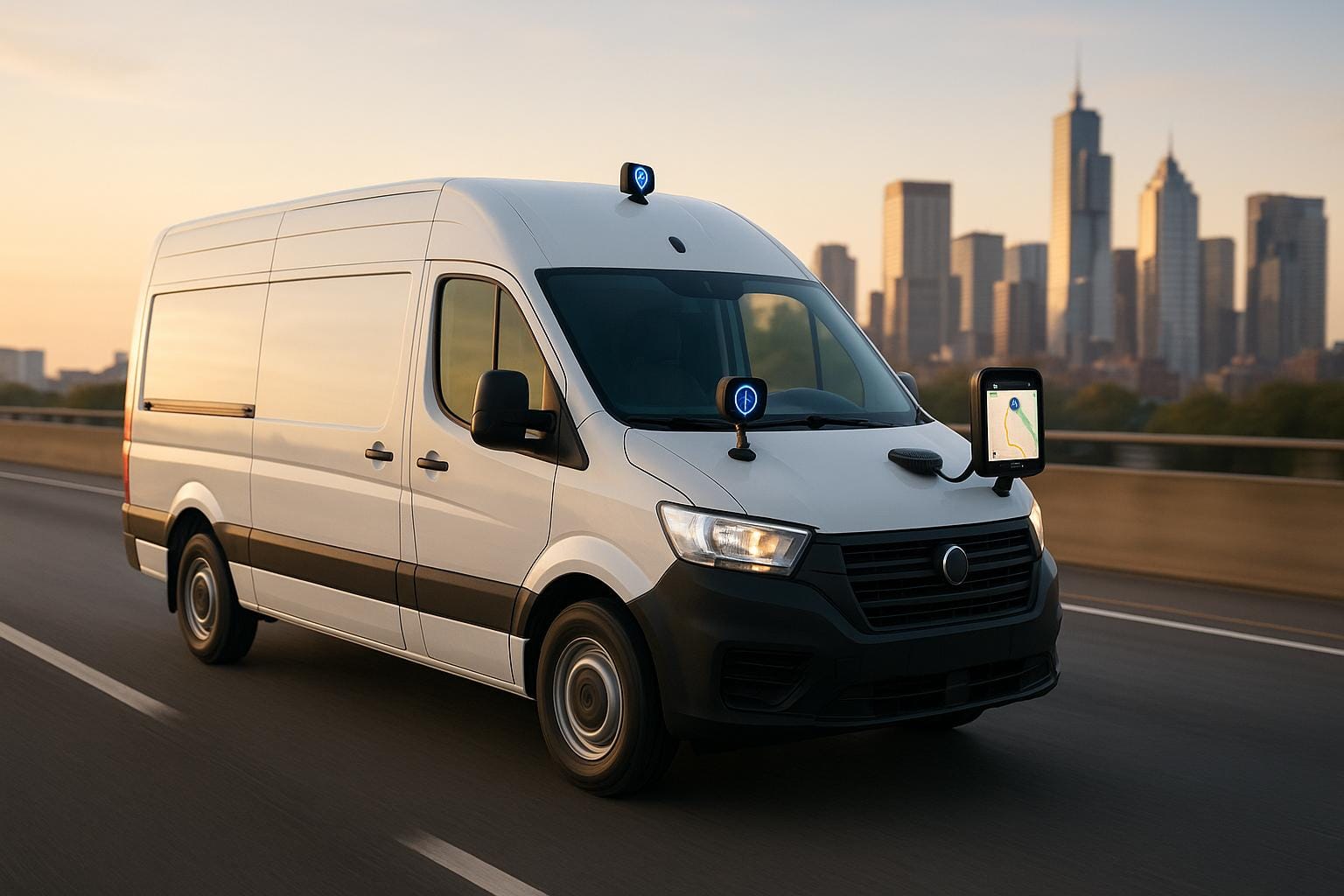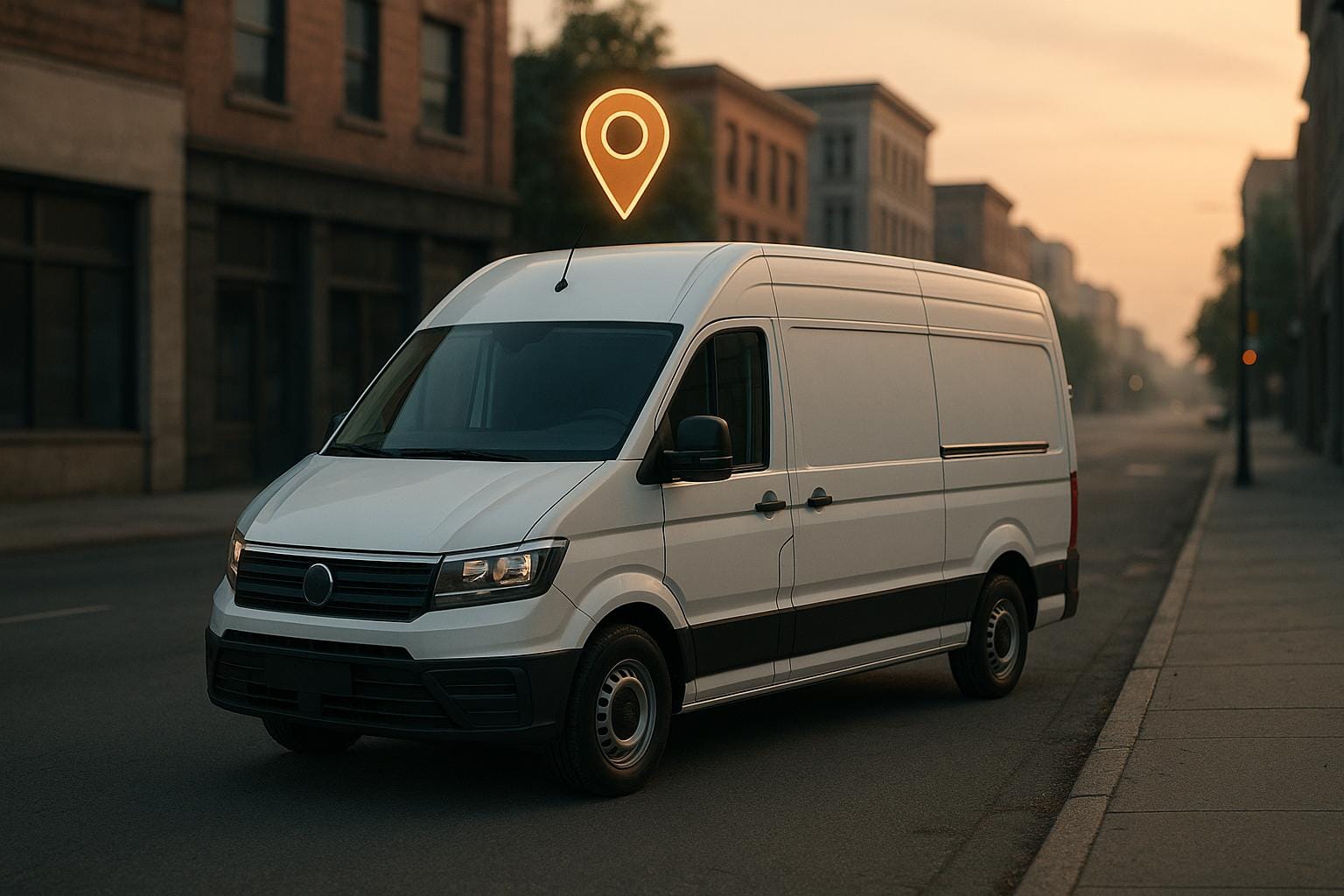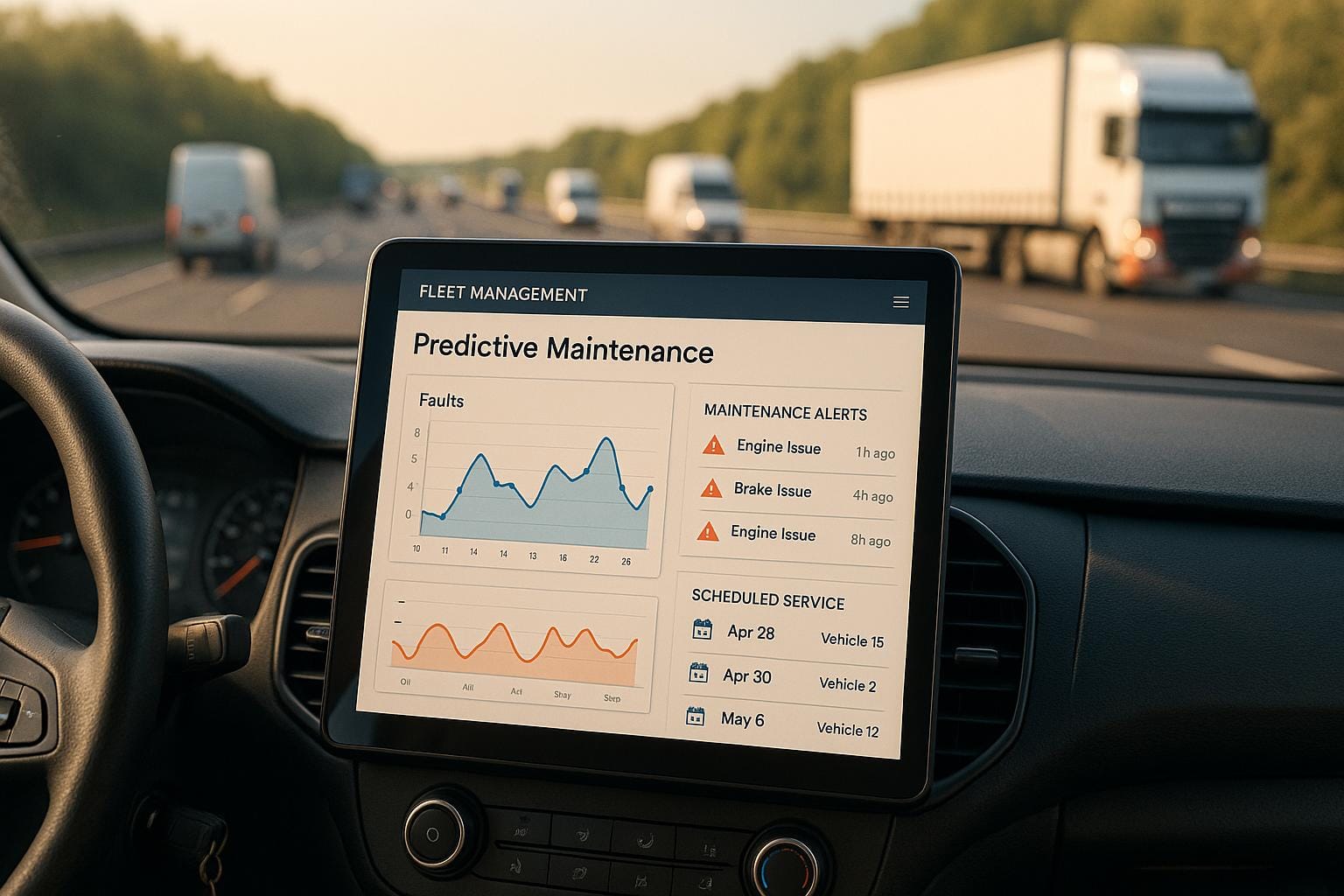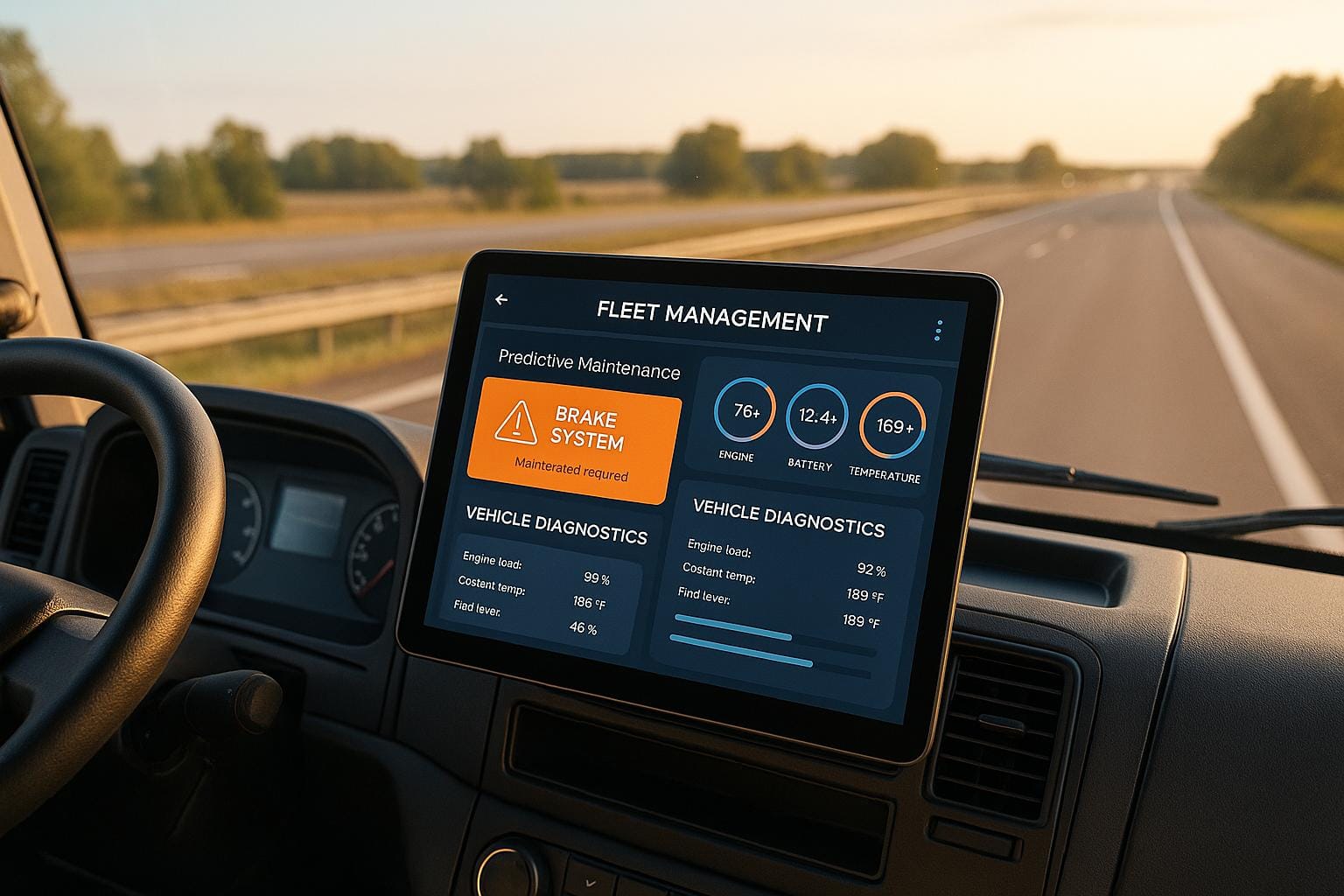Van tracking systems use GPS and telematics to help UK fleet managers improve security, cut costs, and streamline operations. Here's why they're essential:
- Boost Security: 90% of stolen vehicles with tracking systems are recovered, with 80% returned within 24 hours. Features like geofencing, remote immobilisation, and driver authentication protect your fleet.
- Save Money: Reduce fuel costs by up to 15% through better route planning and driving habit monitoring. These savings can add up to £1,000–£2,000 per vehicle annually.
- Improve Efficiency: Real-time updates help optimise routes, avoid traffic, and improve scheduling. Historical data supports long-term planning and compliance.
- Enhance Driver Safety: Monitor speeding, harsh braking, and fatigue to promote safer driving and potentially lower insurance costs.
Quick Benefits Overview
| Feature | Benefit |
|---|---|
| Real-Time Tracking | Immediate updates for theft recovery and routing |
| Historical Data | Analyse routes, performance, and compliance |
| Security Tools | Geofencing, remote immobilisation, driver authentication |
| Cost Savings | Lower fuel and insurance costs |
| Driver Safety | Monitor and improve driving behaviour |
Starting from just £7.99 per vehicle per month, van tracking systems offer an affordable way to protect your fleet, reduce expenses, and stay compliant with UK regulations.
Motive Fleet View | Advanced GPS system for live and ...
Van Tracking System Basics
Modern van tracking systems utilise GPS technology and telematics to offer detailed fleet monitoring tools. Here's a closer look at the essential hardware behind these systems.
GPS and Data Systems
The system's core components include a GPS receiver, an onboard computer, and a telematics unit.
The GPS receiver connects to 24 satellites spread across six orbital planes. This ensures that at least four satellites are always accessible, allowing the system to calculate the vehicle's position and time in three dimensions.
The telematics unit collects vehicle data through the OBD port, which includes:
- Engine diagnostics
- Vehicle speed
- Direction of travel
This information is sent via cellular networks to secure cloud servers, where it is displayed on an easy-to-use dashboard. Fleet managers can then access this data through web portals or mobile apps, providing real-time visibility across their fleet.
Live vs Historical Tracking
Live and historical tracking serve different purposes, each contributing to fleet management in unique ways:
| Feature | Live Tracking | Historical Tracking |
|---|---|---|
| Updates | Real-time, continuous updates | Retrospective, based on stored data |
| Primary Use | Immediate location, route checks, theft recovery | Route analysis, performance reviews, compliance reporting |
| Network | Requires constant mobile data | Data transferred periodically or on demand |
| Storage | Temporary, overwritten regularly | Permanent, for detailed analysis |
This dual system allows managers to address urgent issues while also leveraging data for long-term operational planning.
Live tracking is crucial for immediate operational needs. If a van strays from its route or encounters an emergency, managers receive continuous updates on its location, speed, and status, enabling quick responses.
Historical tracking, on the other hand, builds a detailed record of fleet activity over time. This data is invaluable for analysing route efficiency, evaluating overall performance, and ensuring compliance with regulations.
Together, live and historical tracking provide a comprehensive solution. Live tracking supports daily operations, while historical data lays the groundwork for strategic decisions and ongoing improvements.
Main Advantages of Live Tracking
Live tracking boosts fleet security and streamlines operations, offering tools that protect assets and improve efficiency.
Anti-Theft Protection
Modern tracking systems help prevent theft and aid in quick recovery. Features like redundant tracking and remote immobilisation create a strong security setup.
"After the initial shock it was a real relief to know I had a Tracker on my vehicle, ensuring that it could be located swiftly with everything safe inside." - Mark Keel, KD Doors
One example of its effectiveness: KD Doors in Lanarkshire recovered an engineer's stolen van and tools in just 50 minutes, thanks to a Tracker SVR unit.
Key features include:
- Geofencing alerts: Receive instant notifications if a vehicle exits a set area.
- Remote immobilisation: Disable the engine remotely via a smartphone.
- Out-of-hours monitoring: Get alerts for any unauthorised movements.
- Driver authentication: Ensure only authorised individuals can operate vehicles.
Improved Routes and Fuel Efficiency
Live tracking also enhances daily operations by enabling real-time adjustments to routes and schedules. This not only saves time but also cuts costs.
| Benefit | Impact |
|---|---|
| Route Optimisation | Reduces fuel costs by up to 30% |
| Traffic Avoidance | Minimises idle time and delays |
| Real-time Adjustments | Helps avoid congestion |
| Fuel Monitoring | Identifies inefficient driving habits |
Using real-time data, managers can:
- Monitor traffic to avoid delays and reduce idling.
- Adjust delivery schedules based on actual road conditions.
Driver Safety Tools
Live tracking promotes driver safety with immediate feedback systems. It monitors behaviours like sharp turns, harsh braking, speeding, and fatigue, triggering alerts when necessary.
These tools not only protect drivers but may also lower insurance premiums for businesses using tracking technology. Real-time alerts allow quick action when safety limits are breached, while detailed data analysis helps identify trends for targeted driver training programmes.
Choosing Your Tracking System
When selecting a tracking system for your fleet, it's essential to focus on features that align with your specific needs. The right system should be easy to set up, cost-efficient, and equipped with the tools to improve both operations and security.
Key Features to Look For
Make sure the system you choose includes features that deliver measurable benefits:
| Feature Category | Key Features | Impact on Business |
|---|---|---|
| Security | Geofencing, alerts for unauthorised movement | Helps prevent theft and reduces risks |
| Operations | Job management, nearest vehicle search | Cuts response times and lowers fuel costs |
| Compliance | Digital inspection logs, driving hours tracking | Eases compliance with regulations |
| Performance | Driver scorecards, fuel monitoring | Reduces fuel expenses, maintenance needs, and driver risks |
"Personal data shall be processed fairly and lawfully, shall be adequate, relevant, accurate and kept no longer than is necessary and moreover obtained only for lawful purposes." - Data Protection Act 1998
Once you've identified the features you need, it's time to think about installation and integration.
Setting Up Your System
- Evaluate Your Fleet: Assess the size of your fleet, types of vehicles, and operational priorities.
- Choose Installation Options: Decide between self-installation or professional hard-wiring. Ensure privacy controls are in place, and secure driver consent in line with UK legal requirements.
- Train Your Team: Offer thorough training on the system's features and privacy settings, including tools like privacy buttons for non-work hours.
Clear communication about the system's benefits and privacy measures is crucial for successful adoption.
Managing Costs
After installation, keeping costs under control is vital. Basic tracking services typically start at £7.99 per vehicle per month, with additional features increasing the price.
Here are some cost factors to consider:
- Hardware: Basic tracking devices cost around £35, while advanced security options can go up to £99.
- Subscription Fees: Monthly charges cover SIM cards, data usage, and platform access.
- Installation: Costs can be lowered with bundle deals.
- Insurance Savings: Enhanced security features may lead to lower premiums.
Look for systems that offer:
- Flexible options that can grow with your fleet
- Free installation when bundled with other services
- Pay-per-recovery models with no upfront costs
- Reliable customer support and account management
According to the TS23 telematics survey, driver safety remains the top reason for investing in these systems, making it a worthwhile expense.
UK Fleet Examples
Real-world examples show how van tracking improves security, efficiency, and compliance for businesses in the UK.
Business Results
KD Doors in Lanarkshire demonstrates how tracking technology can save resources and reduce disruptions to operations.
Another success story comes from John O'Conner Grounds and Maintenance, which saw impressive improvements after adopting tracking systems:
| Improvement Area | Results Achieved |
|---|---|
| Fuel Consumption | 25% reduction through optimised routing |
| Vehicle Idling | 30% decrease via driver monitoring |
| Employee Overtime | 15% reduction with better scheduling |
| Overall Productivity | 15% increase in daily job completion |
These changes translate to annual savings of £1,000 to £2,000 per vehicle. Additionally, improved accuracy in arrival times enhances customer service, offering both financial and operational benefits tailored to the needs of British fleets.
UK-Specific Benefits
British fleets face unique challenges, such as navigating narrow city streets and meeting strict emissions standards. Van tracking systems provide features designed to address these issues.
Compliance Support
- Automated tachograph downloads every 90 days
- Collection of driver card data every 28 days
- GDPR-compliant privacy controls with driver consent management
Enhanced Security
The construction industry, often hit hard by equipment theft, benefits from features like:
- Real-time location tracking
- Geofencing alerts for unauthorised movement
- 24/7 recovery assistance
- Access to trained recovery agents across the UK
Fleet managers also gain access to a range of support services, including:
- Professional installation available nationwide
- Flexible payment plans starting at £7.99 per van each month
- Dedicated account management
- Round-the-clock technical support
These solutions are specifically designed to help UK fleet operators stay efficient while managing the country's regulatory and operational challenges.
Conclusion
Real-time van tracking has become a game-changer for UK fleets, boosting security, improving efficiency, and cutting costs. With a 90% recovery rate and 80% of stolen vehicles returned within 24 hours, it's clear these systems are making a difference.
Fleet managers have reported impressive results. For example, transport teams have saved up to £160,000 and improved fuel efficiency by 12% by monitoring driver behaviour. These systems also make it easier to locate vehicles quickly and improve driver safety scores.
"The system provides a fast and reliable audit of who attended each job and when", says M&Y Maintenance.
Beyond saving money, van tracking helps fleets stay compliant with regulations and ensures drivers are accountable. Key features include:
- Real-time location tracking
- Driver performance insights
- Maintenance scheduling
- Geofencing tools
With Ford Transit vans topping the list of the most stolen vehicles in the UK and only a third of stolen vans recovered without tracking systems, the added security alone makes these systems worth it. Combined with operational benefits, van tracking is a smart choice for modern fleet management.
Starting at just £7.99 per vehicle, these solutions offer a clear return on investment. Numerous UK case studies highlight how van tracking continues to play a critical role in protecting fleets and ensuring operational success.
FAQs
How does real-time van tracking help protect your fleet and recover stolen vehicles?
Real-time van tracking significantly improves security by providing live location updates and instant alerts for unauthorised vehicle movements. Features like geofencing can notify you if a van leaves a designated area, enabling swift action to prevent theft or assist with recovery.
In the event of a theft, tracking systems allow you to share precise location data with law enforcement, increasing the likelihood of a quick recovery. Additionally, the presence of a tracking system can act as a deterrent to thieves and may even help reduce your insurance premiums. By implementing these tools, you can enhance fleet security and gain peace of mind knowing your vehicles are protected.
What does it cost to implement a van tracking system, and how can it help save money for your fleet?
The cost of implementing a van tracking system depends on factors such as the features you need, the type of service, and the length of the contract. Some systems involve a one-off purchase, while others operate on affordable monthly subscriptions, with prices often starting at under £10 per vehicle. Installation may also incur an additional cost.
Despite the initial outlay, van tracking systems can deliver significant savings. By optimising routes, improving fuel efficiency, and reducing vehicle wear and tear, fleets can cut operating costs. Additional savings can come from lower insurance premiums, better driver accountability, and streamlined administrative tasks. Many businesses report saving hundreds of pounds per vehicle each month, making tracking systems a cost-effective solution for commercial and construction fleets in the UK.
How can historical tracking data improve long-term fleet management and planning?
Historical tracking data plays a crucial role in improving long-term fleet management by helping you identify patterns and trends in vehicle usage. This information allows you to make data-driven decisions to enhance efficiency and cost-effectiveness.
By analysing past data, you can optimise routes, reduce fuel consumption, and schedule proactive maintenance to minimise downtime. It also helps improve driver accountability and ensures better asset utilisation, ultimately increasing the return on investment for your fleet. Leveraging this data supports more strategic planning and ensures your fleet operates at its best over time.




